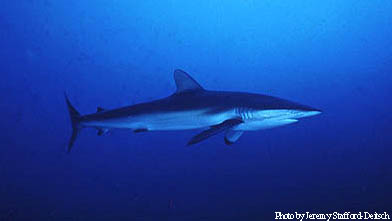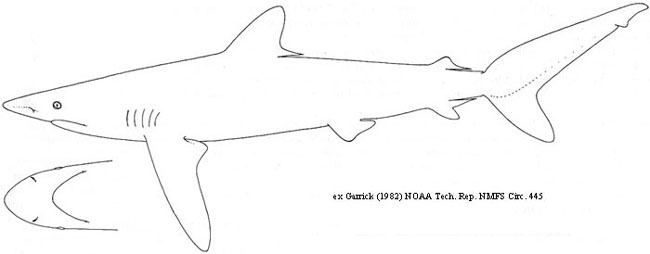SILKY SHARK
Order - Carcharhiniformes
Family - Carcharhinidae
Genus - Carcharhinus
Species - falciformis

Geographical Distribution
Habitat
Biology
Interest to Humans
Conservation
Geographical Distribution

Although essentially pelagic, the silky shark is not restricted to the open ocean and has been recorded from depths as shallow as 18 meters (56 ft). It is an active, swift shark that prefers warmer water (about 23°C). It is commonly found near the edges of continental shelves and over deepwater reefs where there is abundant food source. Typically, it ranges from the surface down to at least 500 meters (1,550 ft) but has been caught over water as deep as 4000 meters (12,4000 ft). Studies show no strong tendency for sexual segregation in the silky shark however, they often travel with others of their own size indicating that size segregation is present within the species. Typically, smaller sharks can be found in coastal nurseries and adults further offshore over deeper water. Small silky sharks are commonly associated with schools of tuna.

· Distinctive Features
A large, slender shark, the silky is characterized by a moderately extended,
rounded snout, a relatively sloping first dorsal fin with a blunt apex that
originates behind the free margins of the pectoral fins, a small second dorsal
fin with an extremely long free rear tip (more than 2x the height), and a
low inter-dorsal ridge. Pectoral fins are long and slender, typically with
dusky tips. The silky shark, so named because its "smooth" hide
(a result of densely packed dermal denticles) is also called the "net-eater
shark" in the eastern Pacific because of its tendency to ravage tuna
seine nets.
· Coloration
Dark gray with a bronzy tint dorsally and white ventrally. Tips of fins other
than first dorsal dusky, more conspicuous in juveniles.
· Dentition
Upper teeth broadly triangular and oblique becoming more diagonal toward the
angle of the jaws, strongly notched laterally, heavily serrated on both sides
(slightly more basally). Lower teeth erect with smooth edges. Usually 1 or
2 symphysial teeth in both the upper and lower jaws.
· Dermal Denticles
Denticles are small, tightly packed and over-lapping giving the hide a smooth
or "silky" texture, hence the common name.
· Size, Age & Growth
Maximum length for this species is 3.3 m (10 ft). Males mature at 215-230
cm (9-10 years of age) and grow to a lesser size than females, which reach
maturity at 230-245 cm (12 years of age), however, these numbers may vary
by population. For example, populations in the Pacific and Indian oceans generally
have a smaller size at maturation. Size at birth is 70-85 cm (2-2.5 ft). Maximum
age is believed to be 22+ years.
· Feeding Behavior
The yellowfin tuna (Thunnus albacares) is commonly preyed on by silky sharks.
This species feeds primarily on a variety of bony fish, cephalopods, and to
a lesser extent, crustaceans. Tuna (little tunny and yellowfin), albacore,
mullet, mackerel, porcupine fish, squid, nautiluses, and various crabs have
all been found in the stomachs silky sharks.
· Reproduction
Reproduction is viviparous (placental). In the western North Atlantic, females
give birth in late spring (May-June) and mate around the same time in alternating
years. The gestation period is about 12 months. Number of sharks per litter
is 6-14 in the western Atlantic, 9-12 in the eastern Atlantic, 9-14 in the
western Indian, and 2-11 in the central Indian. Neonates spend first the few
months in near reefs but move to the open ocean by the first winter. In the
western North Atlantic, nursery areas are located along the Caribbean islands.
Interest to Humans
Jacks (family Carangidae), follow a silky shark in search of a scraps. The
silky shark is of considerable importance to longline and gillnet fisheries
in many parts of the world. In the Gulf of Mexico it is often caught as bycatch
in the tuna fishery but also harvested by the directed shark fishery. In the
Caribbean it is sometimes fished, primarily by longline, but is not a common
catch. In the Maldives and Sri Lanka, it is the most important shark species,
comprising 70-80% of the pelagic longline catch. In Japanese waters, the silky
shark is commonly taken in the directed pelagic shark fishery but also in
the swordfish and tuna fishery as bycatch, while around the mid-Atlantic coasts
of the United States, it is fished but not in significant numbers. It is used
for its meat, oil, and fins. The silky shark is also taken by recreational
fishermen.
Other than its importance to various fisheries, the silky shark has been
used in various scientific studies investigating the sensory biology of sharks.
Conservation
As with other sharks, the silky shark is vulnerable to over-fishing due to its long gestation period, low number of offspring and slow growth rate. Presently, the silky shark is listed as "lower risk" by the International Union for Conservation of Nature and Natural Resources (IUCN).